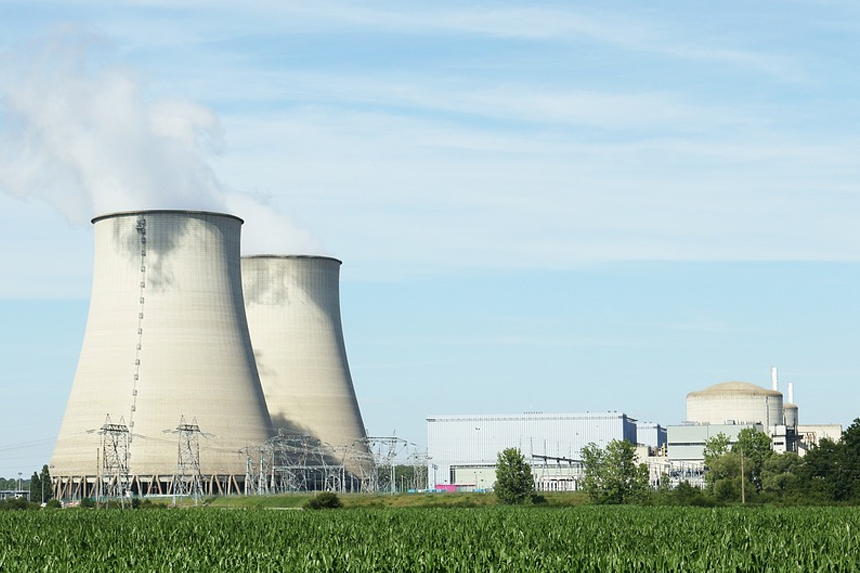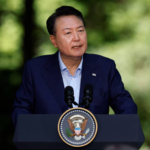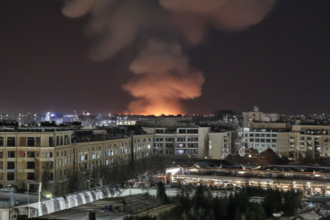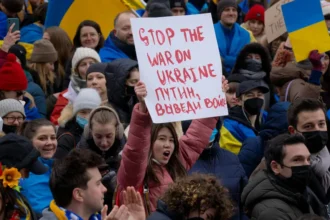The harsh reminder of Ukraine’s Soviet-era past comes from the massive remains of Cold War armaments under a thick grey sky and a small sprinkling of snow. Frozen in time, missiles, launchers, and transporters are a testament to a time when Ukraine was vital in the Soviet Union’s nuclear armament program—the last line of protection against the West.
Within one of the silos, partially covered by a concrete and steel top, a large intercontinental ballistic missile (ICBM) surfaces—just a replica—cracked and mouldy. The silo has been loaded with garbage for about thirty years. Long ago, the vast base— close to Pervomaisis’k, the centre of Ukrainian city—became a museum.
Why did Ukraine decide to give up its nuclear weapons?
Early in the 1990s, Ukraine decided historically to give up its nuclear weapons once it acquired independence. Ukraine agreed to turn over its arsenal in exchange for security assurances from the United States, the United Kingdom, France, China, and Russia, even though it had a third of the nuclear weapons left over from the former Soviet Union.
This historic choice occurred on December 5, 1994, at a ceremony in Budapest. Aimed at guaranteeing the sovereignty and territorial integrity of these recently independent countries, Ukraine, along with Belarus and Kazakhstan, turned off its nuclear weapons in return for promises of international protection.
“The pledges on security assurances that [we] have given these three nations…underscore our commitment to the independence, the sovereignty, and the territorial integrity of these states,” then-President Bill Clinton said, stressing the importance of the deal.
For a young Ukrainian military officer such as Oleksandr Sushchenko, who recently graduated from the military academy in Kharkiv, deactivating the missiles in Pervomais’k seemed like an unavoidable aspect of the post-Soviet change. He remembers seeing the silos blasted up and the missiles taken out as the nation turned away from its Soviet past.
What Long-Term Effects Result from Ukraine Denuclearizing?
But many Ukrainians are reconsidering their choice to decommission their nuclear arsenal as Russia, almost three decades later, launches an unjustified invasion of Ukraine. Now, especially given Russia’s aggressive activities in recent years, the loss of these weapons appears like a blunder.
Sushchenko muses about the circumstances with regret: “My own opinion is that it was a mistake to destroy all the nuclear weapons given what is happening now in Ukraine.” That was a political matter, though. The upper leadership decided, and we followed their directives.
That made sense at the time. Nobody could have foreseen Russia, previously seen as a friend, starting an invasion of Ukraine in the years after the Cold War. Ukraine’s ambassador to London in 1994, Serhiy Komisarenko, notes, “We were naive, but also we trusted. We thought that was plenty when Britain and the United States, then France joined. Furthermore, Russia as well.
Another consideration guiding Ukraine’s choice was the financial cost of keeping nuclear weapons. Still struggling with the economic difficulties of moving from Soviet control, a newly independent Ukraine saw the price of nuclear armaments as intolerable. “Why use money to make nuclear weapons or keep them, if you can use it for industry, for prosperity?” Komisarenko asks.
Why Is Ukraine Reversing the Budapest Memorandum?
Fast forward to now, and the Budapest Memorandum anniversary reminds us of the ineffective security guarantees. “This document failed to secure Ukrainian and transatlantic security,” Ukraine’s foreign minister said, pointing to the paper. We have to stop making such blunders twice through.
His ministry published a statement labelling the Memorandum as “a monument to short-sightedness in strategic security decision-making.” This attitude emphasizes the annoyance Ukraine experiences over the absence of specific security assurances in the face of Russian aggression.
What Security Assurances Ukraine Needs Right Now?
As Ukraine struggles with a continuous battle, the issue guarantees the nation’s future security. For President Volodymyr Zelensky, the only sensible choice is NATO membership.
“The best security guarantees for us are [with] NATO,” Zelensky declared in a Sunday speech. “For us, NATO and the EU are non-negotiable.”
Despite Zelensky’s emotional speech, NATO members remain split about Ukraine’s membership. Although NATO says Ukraine’s road to membership is “irreversible,” the group has not set a precise date for admittance.
NATO partners continue militarily supporting Ukraine in the meantime to improve the nation’s posture before any peace talks. NATO Secretary General Mark Rutte underlined that the more our military support for Ukraine is now, the stronger their hand will be at the negotiating table.
Should Ukraine Think About Reverting to Nuclear Weapons?
Some voices in Ukraine have argued that if the nation cannot depend on the West for long-term security, it may have no choice but to rethink its nuclear policy.
Given this ambiguity, speculations surfaced that the Ukrainian Ministry of Defense had produced a study implying months of easy nuclear device development possibilities. Although the administration has disputed these allegations, the concept is still under debate behind closed doors. Former deputy defence minister Alina Frolova noted that should Ukraine find itself in grave conditions, there is a nuclear option. “That’s a topic under debate among professionals in Ukraine. Should we find ourselves without backing, losing this fight, and must defend our people? It is a possibility.
What remains of the former missile base Pervomais'k?
Given the remains of Ukraine’s previous missile sites lie deserted in the snow, it appears improbable that the country will soon be returning to its nuclear arsenal. One 30-meter-deep command silo still stands at the Pervomais’k facility, mainly kept as it was when it was constructed in 1979. With thick steel doors and underground tunnels linking it to other facility areas, this strongly fortified construction was intended to withstand a nuclear strike.
Inside, a little control room would have been used to send coded commands launching intercontinental ballistic missiles. Former missile technician Sushchenko shows how operators would have turned a key and pressed a button to propel a rocket. Although he does it rather dramatically, the truth of the possible repercussions is frightening.
Sushchenko observes that the choice to destroy the biggest ICBMs was logical. America was no longer considered an adversary, after all. But Ukraine’s nuclear arsenal consisted of a spectrum of tactical missiles with a far smaller range, between 100 and 1,000 kilometres.
As it happened, Sushchenko adds, the adversary was far closer. We could have maintained a few dozen tactical bombs. That would have given our nation-specific security.
In summary, what prospects exist for Ukraine's security and sovereignty in the future?
Ultimately, Ukraine’s decision to renounce its nuclear weapons was a complicated, politically motivated one that seemed appropriate at the time but has come under doubt given current aggressiveness. Now, the nation finds itself at a crossroads, trying to discover security assurances that would assure its survival in a world where the pledges of global agreements might not be sufficient. Ukraine’s past of nuclear disarmament serves as a sobering reminder of the significant cost of peace—and the continuous search for security—as it negotiates this dangerous scenario.








